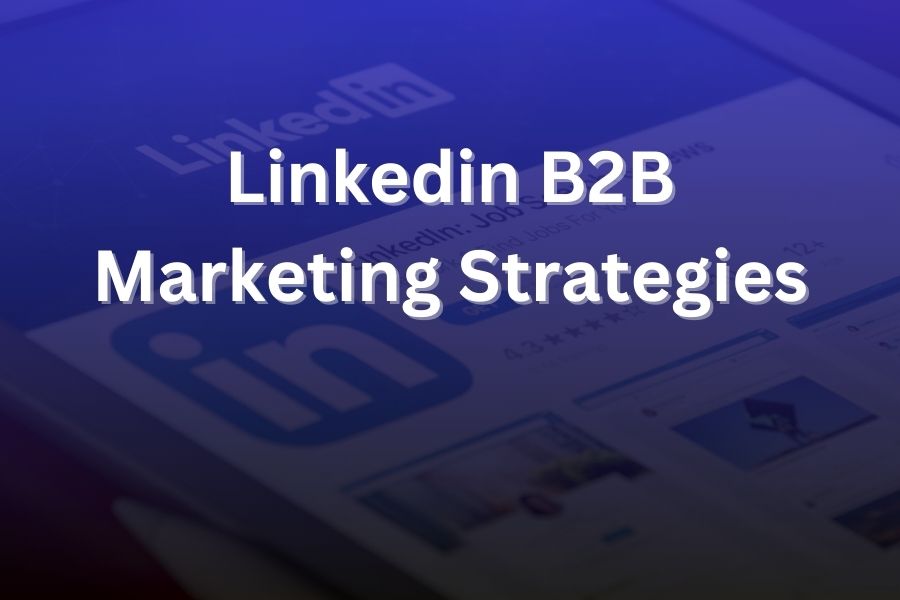LinkedIn B2B Marketing Strategies That Deliver Results

Marketing your B2B business on LinkedIn gives you a chance to reach decision makers, build trust, and generate qualified leads. You need a strategy that uses strong content, precise positioning, and consistent execution to stand out in the competitive professional network.
When you approach LinkedIn with a structured plan, you create visibility, authority, and sales opportunities. In this article you will learn how to build, optimise, and scale your LinkedIn B2B marketing system from the ground up.
Understanding Why LinkedIn Works for B2B
When you target other businesses, your audience is selective and goal-driven. LinkedIn supports these needs because it attracts professionals with higher buying intent. Many B2B marketers choose LinkedIn as their primary platform for lead generation. Ads on the platform often increase purchase intent, and the audience typically has stronger purchasing power compared to general social media users.
LinkedIn also gives you detailed targeting options. You can reach users by job title, company size, industry, skills, and seniority. This precision helps you connect with decision makers without wasting your budget on broad audiences.
Setting Clear Objectives and Defining Target Buyers
Before you create content or run ads, you need clear goals and a defined audience. Ask yourself what business problem you are solving and which roles inside a company care about that problem. Identify who makes the decisions and who influences them.
Your goals may include improving brand visibility, generating more qualified leads, or helping your sales team shorten the buying journey. Strong B2B marketing focuses on the people behind the companies. Create buyer personas that describe their challenges, your solutions, and the type of content they need to move forward.
Optimising Your Company Page and Leadership Presence
Your LinkedIn Company Page acts as a first impression. Use a clean header image and write a clear tagline that reflects your solution. In your “About” section, speak directly to your ideal buyers. Focus on the problems you solve and the outcomes you deliver.
Share updates consistently. Post case studies, insights from your team, behind-the-scenes content, and short educational posts. Encourage employees to update their profiles and share content from your company. People trust real individuals more than brand-only messaging, so humanising your presence helps you build credibility.
Creating Content That Moves Prospects Through the Journey
Your content must support each stage of the buyer’s journey. At the awareness stage, people need educational insights, industry trends, short videos, and simple infographics. At the consideration stage, they need deeper materials such as guides, comparisons, and case studies. At the decision stage, prospects want demos, consultations, and proof of results.
Visual content performs well on LinkedIn. Carousels and infographics tend to drive more engagement than plain text posts. Short vertical videos often perform better on mobile because they feel natural and easy to consume.
Keep your paragraphs short and open your posts with a strong first line. Your call to action should be clear, direct, and value-focused.
Growing Engagement and Building Relationships
LinkedIn rewards consistent and meaningful engagement. Join discussions in relevant LinkedIn Groups where your audience is active. Comment on posts from industry leaders and potential customers. Share insights instead of trying to sell immediately.
Use a small number of relevant hashtags to improve reach. Encourage your team to share company content with their own voice. Employee advocacy expands your organic reach and helps your brand appear more trustworthy.
Using LinkedIn’s Paid Tools with Precision
Organic content builds trust, but paid tools help you scale. Sponsored Content and video ads increase awareness. Lead Gen Forms help you collect high-quality leads without sending users off the platform. Message ads allow you to speak directly to decision makers. Retargeting helps you stay visible to people who visited your website.
Paid campaigns work best when you combine precise targeting with strong creative. Clear headlines, simple visuals, and concise offers often produce the best results.
Implementing Account-Based Marketing on LinkedIn
Account-based marketing narrows your focus to specific companies that bring the highest value. You can identify the right people within those companies, then create personalised content that speaks to their needs. Use targeted ads, personalised outreach, and coordinated messaging between your marketing and sales teams.
Track engagement at the account level. When you see multiple stakeholders interacting with your brand, the chance of conversion increases.
Measuring Performance and Improving Your Strategy
Monitor the metrics that matter most to your goals, such as impressions, engagement, leads, and pipeline activity. Combine LinkedIn Analytics with your CRM to understand what content is working and where prospects drop off.
Test different formats, headlines, visuals, and targeting groups. Small adjustments often create meaningful improvements. Use performance data to guide your next steps rather than relying on guesswork.
Scaling Your LinkedIn B2B Marketing Program
Once you gain traction, you can scale carefully. Repurpose top-performing posts into new formats. Expand your audience slowly, keeping your message consistent. Support your sales team with content they can use in outreach.
Quality is more important than quantity. B2B buyers respond to brands that share helpful, thoughtful, and well-presented insights. Maintain a high standard as you grow.
Staying Ahead of Trends and Algorithm Changes
LinkedIn continues to evolve, so your strategy must adapt. The platform places more emphasis on visual content and mobile-first experiences. Decision makers consume more thought-leadership content than ever before. Short educational videos, carousels, and expert commentary continue to perform well.
Stay updated on industry shifts and keep testing new content types. The brands that stay flexible remain visible and competitive.
Conclusion
Strong LinkedIn B2B marketing comes from clear goals, consistent content, personalised communication, and data-driven adjustments. When you combine organic engagement with smart paid campaigns, you reach the right buyers at the right time.
Keep improving your messaging, building relationships, and adapting to new trends. With commitment and the right strategy, LinkedIn can become one of your strongest channels for growth and revenue.
